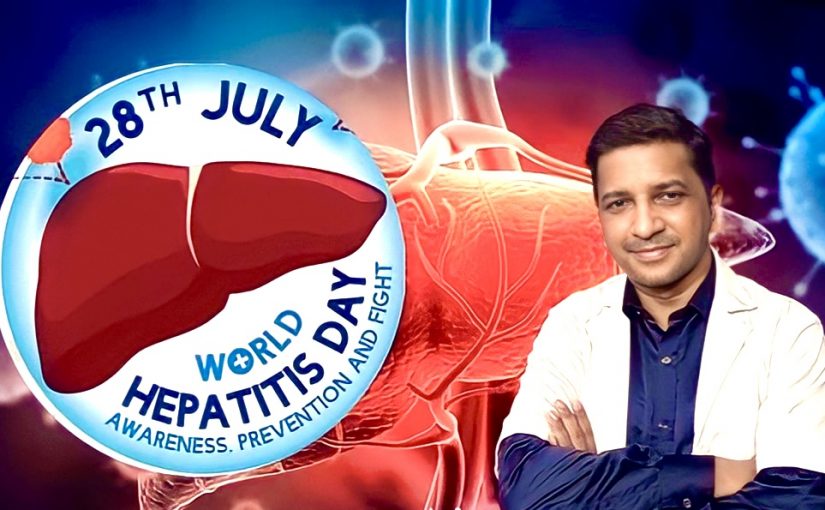A World Hepatitis Day Special
July 28 is observed as World Hepatitis Day. We catch up with DR AMIT DIAS from the Department of Preventive & Social Medicine to learn about the A, B, C, D & E of hepatitis. He shares the good news that hepatitis B and C can now be cured and we can prevent their long-term complications like cancer of the liver…an informative question/answer session….
QUESTION: DOCTOR, WHAT EXACTLY IS HEPATITIS?
DR AMIT DIAS: Hepatitis is the inflammation of the liver. This swelling can impair liver function and can occur when the tissues get injured or infected. It usually results in jaundice which in local language is referred to as “kamin.” The infection can be acute (short duration) or chronic (long duration). Alcohol, toxins and certain medications can cause hepatitis. However, the most common cause is the hepatitis virus infection. The WHO has a very interesting theme this year — One Life: One Liver. It’s a reminder that we have one life and one liver…Hepatitis can destroy both of them. We have over one million hepatitis-related deaths every year and one new chronic infection every second!! Most of them go undetected.
Q: WHAT IS THE ROLE OF THE LIVER IN OUR BODY?
A: The role of the liver is very crucial. It’s the second largest organ in the body. Without our knowledge, the liver performs over 500 vital functions of our body and keeps us alive. It stores nutrients, supplies glucose to the brain, builds immunity, it detoxifies, helps in blood production, etc. It’s a vital organ and damage to the liver can be fatal.
Q: WHY IS HEPATITIS DAY OBSERVED?
A: This is one of the nine flagship health campaigns of the WHO. The day is used to raise awareness of some of the most common forms of viral Hepatitis to scale up viral hepatitis prevention, testing, and treatment to achieve the elimination goals by 2030.
Q: CAN YOU ELABORATE ON THE MOST COMMON FORMS OF VIRAL HEPATITISs?
A: The most common forms are hepatitis A, B, C, D, and E.
All five of these viruses can cause liver inflammation, but they are uniquely different in terms of their mode of transmission, complications, prevention, and treatment.
Hepatitis A and E viruses are faeco-orally transmitted through contaminated food and water. While Hepatitis B, C and D are transmitted parenterally through body fluids, including blood, in the same way as the transmission of the HIV Virus.
Q: WHAT ARE THE SYMPTOMS OF HEPATITIS?
A: The common symptoms are fever, jaundice or yellowing of the skin and eyes, nausea, vomiting, loss of appetite, pain in the abdomen, clay-colored stools, dark-colored urine, pain in the joints, etc. In acute hepatitis, one can get the symptoms for up to 6 months. Chronic hepatitis can affect for a long period and can last for decades as seen in Hepatitis B, C and D. People can become carriers of hepatitis, and not everyone with hepatitis will have symptoms and jaundice. One may not know that they have hepatitis till there is considerable damage to the liver. Screening is very important.
Q: WHAT IS NEW IN THE MANAGEMENT OF HEPATITIS?
A: There are a lot of new encouraging developments in the management of hepatitis. In India, we have a new program called the National Program for the Control of Hepatitis which was launched in India on World Hepatitis Day 2018.
There are very effective antivirals that are now available that can cure Hepatitis C and control hepatitis B, which are game changers. The vaccine for hepatitis B is given to all children under the National Immunization Program for quite some time. Similarly, we have been screening blood for Hepatitis B and C for the last few years. We had a vaccine for hepatitis A and now we even have a vaccine for hepatitis E which has been licensed in China, though not yet available to the rest of the world.
Q: WHAT’S THE WAY FORWARD?
A: The World Health Organisation has set a goal to eliminate hepatitis by 2030. We have a good vaccine to prevent hepatitis B, which indirectly also prevents Hepatitis D infection. We also have good evidence-based anti-virals that can cure hepatitis C and keep hepatitis B under control. With these tools in hand, we can dream of eliminating hepatitis by 2030.
The WHO is aiming to reduce the new infections of hepatitis B and C by 90%, reduce hepatitis deaths by 65%, and ensure that 90% of people infected by Hepatitis B and C viruses are screened and at least 80% of infected individuals receive appropriate care.
Q: WHAT IS YOUR MESSAGE FOR READERS?
A: The slogan for World Hepatitis Day this year is “Can’t Wait.” Hepatitis does not wait, it can kill us, and we need to take action before it does. As I mentioned earlier, we have one million hepatitis-related deaths every year and one new chronic infection every second. The good news is that these deaths and infections can be prevented and hepatitis can be cured. We need to raise awareness of preventive strategies, provide the vaccine, and screen, detect, and cure people who have infections. People at risk “can’t wait” to get tested, expectant mothers “can’t wait” for hepatitis screening, children “can’t wait” to get their hepatitis B vaccine, and people “can’t wait” to get their life-saving medications.
Let us all respond by saying — “We are not waiting, we will join the mission to eliminate hepatitis!”
(About the author: Dr Amit Dias is Asst Professor at the departmne of Preventive and Social Medicine at the Goa Medical College. He has also completed his post-graduate diploma in tropical medicine at the London School of Hygiene and Tropical Medicine, UK.)
